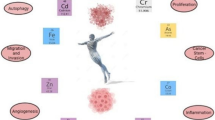Abstract
As is well known from earlier studies, the genotoxic effect of lead exposure was partly attributed to the formation of the highly reactive oxygen metabolites (ROMs) in the blood. However, lead ions have no ability to generate ROMs. Therefore, the recently published studies paid more attention to the role of δ-aminolevulinic acid (ALA) accumulation in lead-induced DNA damage. If the above-mentioned assumptions were taken into consideration, it seemed a reasonable approach to study the possible protective effects of antioxidants against genotoxic effects of lead. According to our results, N-acetylcysteine (NAC) and melatonin (MEL) were able to reduce significantly (p < 0.05) the lead- and ALA-induced sister chromatid exchange frequencies in human lymphocytes in vitro. In spite of a relative reduction in the lead- and ALA-induced micronucleus formation in human lymphocytes, the reduction was not statistically significant (p > 0.05). These results could be evaluated as supportive evidence for the hypothesis that increased antioxidant capacity of cells might fortify the efficiency of protective pathways against cytogenetic damage in lead exposure.
Similar content being viewed by others
References
F. M. Johnson, The genetic effects of environmental lead,Mutat. Res. 410, 123–140 (1998).
J. Paakkanen, M. Sorsa, and H. Vainio, Chromosome aberrations and sister chromatid exchanges in lead-exposed workers,Heriditas 94, 269–275 (1981).
P. Grandjean, H. C. Wulf, and E. Niebuhr, Sister chromatid exchange in response to variations in occupational lead exposure,Environ. Res. 32, 199–204 (1983).
Y. Duydu, A. Dur, and H. S. Suzen, Evaluation of increased proportion of cells with unusually high sister chromatid exchange counts as a cytogenetic biomarker for lead exposure,Biol. Trace Element Res. 104(2), 121–129 (2005).
L. Beckman, I. Nordenson, and S. Nordstrom, Occupational and environmental risks in and around a smelter in northern Sweden, VIII. Three year follow up of chromosomal aberrations in workers exposed to lead,Heriditas 96, 261–264 (1982).
C. Winder and T. Bonin, The genotoxicity of lead,Mutat. Res. 285, 117–124 (1993).
Y. Duydu, H. S. Suzen, A. Aydin, et al., Correlation between lead exposure indicators and sister chromatid exchange (SCE) frequencies in lymphocytes from inorganic lead exposed workers,Arch. Environ. Contam. Toxicol. 41, 241–246 (2001).
A. Hartwig, Role of DNA repair inhibition in lead- and cadmium-induced genotoxicity: a review,Environ. Health Perspect. 102(3), 45–50 (1994).
M. Yusof, D. Yildiz, and N. Ercal, N-Acetyl-L-cysteine protects against δ-aminolevulinic acid-induced 8-hydroxydeoxyguanosine formation,Toxicol. Lett. 106, 41–47 (1999).
D. M. Fiedler, P. M. Eckl, and B. Krammer, Does δ-aminolevulinic acid induce genotoxic effects?J. Photochem. Photobiol. B: Biolog. 33, 39–44 (1996).
M. R. Moore, A. Goldberg, and A. A. C. Y. Laiwah, Lead effects on the heme biosynthetic pathway,Ann. NY Acad. Sci. 514, 191–203 (1987).
E. J. H. Bechara, Oxidative stress in acute intermittent porphyria and lead poisoning may be triggered by 5-aminolevulinic acid,Braz. J. Med. Biol. Res. 29, 841–851 (1996).
P. Mascio, P. C. Teixeira,. Onuki, et al., DNA damage by 5-aminolevulinic and 4,5-dioxovaleric acids in the presence of ferritin,Arch. Biochem. Biophys. 373(2), 368–374 (2000).
H. Gurer and N. Ercal, Can antioxidants be beneficial in the treatment of lead poisoning?Free Radical Biol. Med. 29(10), 927–945 (2000).
M. Karbownik and R. J. Reiter, Melatonin protects against oxidative stress caused by δ-aminolevulinic acid: implications for cancer reduction,Cancer Invest. 20(2), 276–286 (2002).
P. Perry and S. Wolff, New giemsa method for the differential staining of sister chromatids,Nature 251, 156–158 (1974).
M. Fenech, The in vitro micronucleus technique,Mutat. Res. 455, 81–95 (2000).
C. T. Zapico, J. M. Fraga, M. J. R. Colunga, D. Tolivia, R. Hardeland, and A. C. Montes, Melatonin protects against δ-aminolevulinic acid-induced oxidative damage in male Syrian hamster Harderian glands,Int. J. Biochem. Cell Biol. 34, 544–553 (2002).
S. J. Flora, M. Pande, G. M. Kannan, and A. Mehta, Lead induced oxidative stress and its recovery following co-administration of melatonin or N-acetylcysteine during chelation with succimer in male rats,Cell. Mol. Biol. 50, 543–551 (2004).
F. G. Princ, A. A. Juknat, A. A. Amitrano, and A. Batlle, Effect of reactive oxygen species promoted by delta-aminolevulinic acid on porphyrin biosynthesis and glucose uptake in rat cerebellum,Gen. Pharmacol. 31(1), 143–148 (1998).
A. Matsuoka, C. Lundin, F. Johansson, et al., Correlation of sister chromatid exchange formation through homologous recombination with ribonucleotide reductase inhibition,Mutat. Res. 547, 101–107 (2004).
E. Sonoda, M. Sasaki, C. Morrison, Y. Y. Iwai, M. Tokata, and S. Takeda. Sister chromatid exchanges are mediated by homologous recombination in vertebrate cells,Mol. Cell. Biol. 19(7), 5166–5169 (1999).
M. Fenech, Important variables that influence base-line micronucleus frequency in cytokinesis-blocked lymphocytes: a biomarker of DNA damage in human populations,Mutat. Res. 404(1–2), 155–165 (1998).
Author information
Authors and Affiliations
Rights and permissions
About this article
Cite this article
Üstundag, A., Duydu, Y. The influence of melatonin and N-acetylcysteine in δ-aminolevulinic acid and lead induced genotoxicity in lymphocytes in vitro. Biol Trace Elem Res 117, 53–64 (2007). https://doi.org/10.1007/BF02698083
Received:
Accepted:
Issue Date:
DOI: https://doi.org/10.1007/BF02698083




